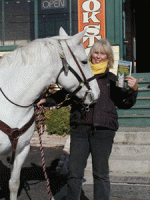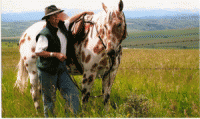Backcountry Riding in Alberta



I always like to talk to fellow riders when I am beginning to research a new area to go horseback riding in order to get personal recommendations on great places to ride. During my research on riding in Alberta in preparation for an upcoming Equitrekking film shoot, I was fortunate to be able to speak with Pam Asheton, author of “Alberta Backcountry Equestrian One-Day Trail Guide” and a former British Horse Society certified teacher and rider with over 30 years experience.
Pam knows riding in Alberta, and I thought that her extensive knowledge of the backcountry would be interesting for Equitrekking readers.
Here are excerpts from my interview with Pam Asheton. I’ll let you know what I suggest after my travels there in July.
Darley Newman: What are your three favorite Alberta trails and why?
Pam Asheton: Alberta riders are truly blessed - you can opt for a one-day number just up the road or for more serious backcountry riding take pack horses in and go high, high, high. The whole of the eastern slopes of what the native people called 'the shining mountains' are rideable right from the Montana border to way up northwards to the Wilmore Wilderness areas. And, each of them has a very distinct personality.
For me, as I live westwards of Calgary, my own up-the-road numbers would, first choice, be the Deer Ridge Trail looped up with the Eagle Hill ride. I park by the open ancient meadows of Sibbald Flats and straightaway access the clearly marked trail up Deer Ridge where's there's a fabulous viewpoint down the valley that was inhabited 11,000 years ago just after the last ice age covered Calgary. You need mountain fit horses. There's climb here and if it's summer I time it outside of the hot afternoon hours. The trail then winds down, joins onto the Eagle Hill trail, then through amazing wildflowers and poplars before you climb, climb, climb again to Eagle Hill, where the view is a knockout, the best, right down the whole of the Bow Valley. Hikers like the viewpoint too, so I tend to go mid-week.
Next would be up in the Ghost, where ATV and OHV traffic has been moved out of critical watershed access areas. In the spring and fall this area is bang on the golden eagle migration highway route, and the wildlife and wild horses (be mindful if you're riding a mare as stallions like to add to their harems!) in its remote areas are second to none. The Side-Hill trail has stunning July wildflowers, with the creek heard far below, while further along towards Devil's Head are the remains of a succession of beaver dams that once stood higher than your tallest basketball players.
Southwards by around 50 or so miles and west of Turner Valley is what ranchers call 'God's Country'. It is. I've often parked at a small trailhead just west of the Sandy McNabb Equestrian Campground, and ridden up along the Foran Ridge, sliding down Windy Point and then onto a loop through Death Valley. Parts north of Windy Point have a few serious springs that can bog up so I go when the weather's been hot and the wind drying late summer. I've watched a cougar threading through grazing cattle, two lynx playing on a windless afternoon. The latter part of the loop back clockwise is actually an old native trading route, ancient, and sometimes I've felt as if the spirits of their horses have accompanied alongside.
Darley: For riders who are bringing their own horses and want an easier trail with scenic views, what do you suggest?
Pam: Personally, yes, I'm a view freak so I can empathize with great scenery! A nice cruisy number is to take the Sheep River Trail westwards of Sandy McNabb Equestrian Campground. It's good footing, not many rocks and easy on horses' legs. You're riding straight towards Blue Rock and Gibraltor, real monuments. The trail slides down to the river and falls, and a great place to picnic. Be mindful, though, that the Sheep can really swell with run-off during the late spring melt, and the white noise crossing the bridges unnerves some horses.
Darley: What’s a more challenging scenic riding option that you might recommend?
Pam: For this number you need fit horses, and to carry water. This one's a two-trailer option, so that you start at the Mount McDougall Memorial on the graveled Powderface Road, and then climb, climb, climb (and climb!) the Jumping Pound Ridge Trail, head towards the cairns of Cox Hill and finish up at the Dawson Equestrian Campground. There's NO water for horses on this excursion, so I time it with heat/temperatures in mind. Cox Hill, in whiteout fog, has no markers and the downhill northerly zig-zag trail downward back into the tree line can be murderous if there's frost in the ground. On a fit horse and carrying liter bottles in my sandbags that I tip into the sides of their mouths at puff stops, it's a significant-- I'm at the top-of-the-world experience-- and a day to remember. On the high meadows at dawn and dusk you can often see elk. It's along a wildlife corridor so if you're windy about encountering cougar or bear, this may not be your ideal outing, but special indeed if you and your horses are OK with that deal.
Darley: What are some safety tips to keep in mind when exploring the backcountry of Alberta or the backcountry in general on horseback?
Pam: Safety to me is a big, big deal. I carry knives-- one on my belt, one on a back cinch, one in the saddlebag, two in the trailer. Waterproof matches on your person (not much point if your horse has just galloped off into the distance with those in the saddlebags!). I always tell someone the route we're going and expected time back, and the emergency numbers for them to ring if there's no action by the appointed time. Cell phones are pretty useless in most areas, and rentable satellite phones that weigh about a pound can be life-savers, literally. It's why, when I'm teaching, I advise people to learn how to read map coordinates, so you can relay those to the rescue teams; it can save them valuable locating time.
Darley: Have you ever had to deal with a dangerous situation on the trails? What happened and what did you do?
Pam: If you ride enough hours, there's inevitably going to be a situation sometime.... The worst for me was in the height of rutting season when a huge, very handsome moose decided my white mare was the answer to his dreams. She wasn't quite that enamored, pirouetted in a rear that Roy Rogers would have been proud of, and then we cannoned at serious speed down a scree slope with a Douglas-fir of venerable years bang in our approach route. It wasn't very pretty to watch but we hauled, just, around that tree's trunk.... the seat of my saddle still has the spur rowel marks from how low I had to hang over the side to avoid being decapitated. Bears she doesn't give a stuff about but even four years later, if she spots a moose a mile away, I know we might as well just go back home for the day as her memory cells kick in. Because we've done a lot of training together, she'll listen and not panic but it's a tense horse I'm riding by then - and you have to recognize and honor that a horse's memory is second only to an elephant's in the animal kingdom.
Darley: What research resources do you recommend to equestrians who would like to ride Alberta’s backcountry?
Pam: When I researched the book, I plagued the life out of naturalists, botanists, ranchers, wardens and outfitters who'd been there and done it… then read every related book available. To me the fascination is knowing why a creek's got a certain name, how poplars can give you sunscreen dust from their bark, the geology alone in the mountains, where you can be 5000 feet up and see seashells imprinted from 80 million years ago....amazing! Trail Training by Judi Daly is good practical advice, so too is Blue Creek Outfitting Trail Riding, Packing and Training Manual by Stan Walchuk.
Darley: What should people keep in mind when choosing trails?
Pam: Think heat, cold, weather forecasts. If there's snow or frost on the ground, aim for south-west facing slopes. If it's hot, does the trail you're aiming for have water for your horse? Sunstroke and heatstroke, for humans AND horses, can be life-threatening. I look at the maps and all those little lines jammed close together and work out if my horse is that fit to cope with the climb ratios… those kind of details.
Darley: What are some must have items that riders should pack for a day in Alberta’s backcountry?
Pam: Layers! This province can go from sweating in a T-shirt to a snowstorm in 20 minutes, any time, so I always carry layers in the saddlebags. And, a pair of dry socks. A spare pair of glasses (or contacts), a first aid kit that you actually keep stocked up, and a really good horse pick or horseman's tool capable of taking out the most stubborn rocks, or heaving off a shoe.
Darley: What’s your favorite part of riding in Alberta?
Pam: When I wrote the book, I used to finish a day and think, nope, it can't get better than today. And, the next time I'd go out, it would be. Better, different, always something significant that connected with your mind and your horse, the magic of really using five senses so well you developed the sixth. The infinite variety of landscapes, the history behind a trail even being there, watching five grey wolves watching you when snow is sparkling in a million diamonds... each area has its own definite personality and they all end up seducing you.
Pam Asheton is a backcountry equestrian, who lives on a ranch in Alberta. She writes about her experiences in various publications including Western Horseman, Canadian Cowboy Country and her recent book, “Alberta Backcountry Equestrian One-Day Trail Guide.” Learn more at seriousbackcountry.com
Purchase Equitrekking DVDs in our online store. Learn about equestrian vacations and book horseback riding adventures at EquitrekkingTravel.com




